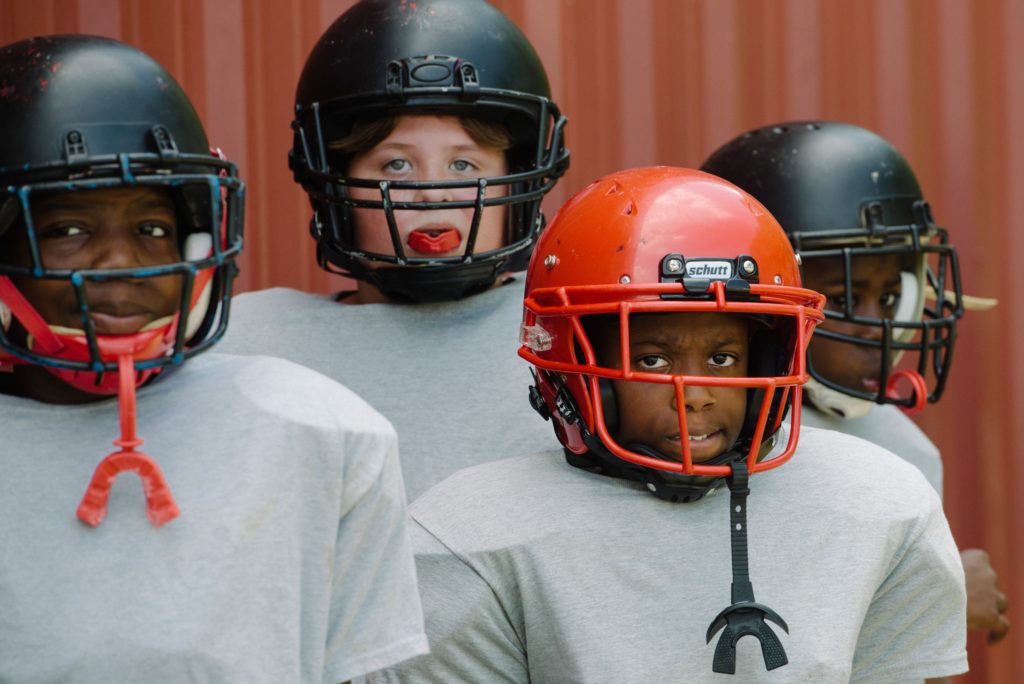Over the course of the last decade or so, football, the most popular sport in the U.S., has weathered blow after debilitating blow.
There’s been a rash of studies confirming the dangers of repeated head trauma at every level of the game. Then came the highly publicized depravity among the collegiate coaching ranks. Since, the list goes has only grown longer.
Despite remaining America’s most popular sport, football is struggling. Over the last decade, high school tackle football participation has fallen by about 10% nationwide.
It’s not just that fewer kids are playing. The racial makeup of the game is shifting, too. White participation in high school football has fallen precipitously in the last decade. At the collegiate level, black athletes make up nearly half of all Division I college football players, up from 39% in 2000. White athletes comprise just 37%, down from 51% in the past.
Still, the United States remains peppered with communities where football is an essential part of the culture, regardless of demographics. And while there’s practically a consensus that the game needs to be made safer, those places have differing ideas of what increased safety looks like.

In 2019, California passed groundbreaking legislation limiting full-contact practices among youth teams. It also saw Texas’s Prosper High School open a brand-new $53 million football stadium that seats 12,000 and features the largest video board of any high school stadium in the state, with a sideline ER medical tent and mobile X-ray machines.
Still, while the Friday night lights continue beaming outside of thousands of schools nationwide, more communities are shuttering programs over safety concerns, dwindling rosters, and re-appropriated budgets.
Recently, a group of New York Times sports writers and graphics experts decided to get to the root of the downward trend, developing the “On Defense,” a serial snapshot of football in America at the onset of the 2020s.
The first piece of the Times’ multi-week series printed in early November. Titled, “Inside Football’s Campaign to Save the Game,” it sets the tone for the series, providing statistical context for the project before focusing on a small high school in Maiden, North Carolina that’s seen its football participation plummet.
The second installment, “A Small Town Gave Up Tackle Football. It Came Storming Back,” published a week later. It zeroes in on Marshall, Texas, and a football program that was portrayed as the season-opening opponent in the iconic 2004 film, Friday Night Lights.
A third story, “The Vitality of Six-Man Football,” followed at the end of November, zooming in on Nebraska’s alternative high school football movement.
Game Plan recently caught up with NYT sports graphics editor Joe Ward and football reporter Ken Belson—both contributors to the series—to learn how a comprehensive multimedia, multi-story, and multi-author project like this comes together.

It All Started at an NFL Meeting
Although this particular series was about six months in the making, Ward says its seeds were planted years ago, when the pigskin illuminati convened in a New York City hotel room to discuss the future of their game.
“In 2017, some of the highest-ranking people in football got together and decided, ‘we better do something because we might be losing the grip on this,’” says Ward.
Reporters Ken Belson and Joe Drape knew of the meeting, which featured numerous NFL owners including the Patriots’ Robert Kraft, NFL Commissioner Roger Goodell, the heads of major college football conferences, and some high-profile ex-players.
They deposited the anecdote into the memory bank, where it lay untouched for nearly two years.
The Initial Pitch
Early last summer, Ward met with NYT Executive Editor Dean Baquet. They discussed preliminary plans for a probe into the current state of football in America.
“We were talking about how to take this moment in time and take the temperature of football in America,” Ward says.
From there, he started to plan. What would such an examination look like? How many graphics could he contribute to the project and what would they be?
“I had gone to Randy Archibold, the [NYT] sports editor,” Ward continues. “He said he would like to combine that idea with Joe and Ken’s reporting around the country. Could we marry these two ideas into the first piece that laid the groundwork for this whole project?”
With the 2017 meeting as a potential jumping-off point, the series began to take shape.

What Does the Data Say?
Before the NYT’s team could conduct any in-person reporting, they had to slog through a heap of state-by-state data. NYT Graphics Editor Quoctrung Bui combed through statistics from the National Federation of High School Associations, measuring player participation rates.
Sometimes, the data wasn’t fully reliable.
“We didn’t want to take the data at face value,” Ward says. “We called up [each state] and asked questions like, ‘we want to make sure you haven’t changed the way you’re collecting this data and that’s why it looks different.’”
What Ward and Bui found was that participation was down almost unilaterally. Only one state, Pennsylvania, had more boys playing high school football in 2018 than in 2009.
There was a variety of reasons behind this trend. Some states reported that parents were pulling their kids out of football entirely, or that kids were electing to play other sports on their own. Some, like Kansas, cited budgetary constraints.
“[Former Kansas] Governor [Sam] Brownback has cut back lots of budgets in the state and so schools had to make tough decisions on where that money should go,” explains Ward. “Football can take up a lot of money from a school budget. Lots of schools were going to six- and eight-man teams instead of 11-man teams.”
A Perfect Case Study
“On Defense,” begins in Maiden, North Carolina, at a school that’s seen its football roster dwindle over the past decade.
Maiden was chosen, specifically, because it featured all the big trends converging in one small town.
In Maiden, football is a big part of the community. The school, which enrolls about 800 students, was substantial in size and fairly racially diverse. And over the past 10 years, football participation has been in steady decline.
“[Maiden] was designed to set the scene for everything else,” says Ken Belson, who reported the story from Maiden. “We found that the town of Maiden and the school there were the closest fit to what the data was telling us about the trends overall. [The editors] discovered this and said, ‘Why don’t we use this school as a vehicle?’”
“This was the rare case where the reporting worked outside-in,” he adds.

Sometimes Reporting Is Quick….
Generally, when Belson reports from a place he’s never been before, preparation is paramount.
“Normally, I would be spending hours in the local newspaper’s websites, football, MaxPreps, calling people I know…you never know what you might find,” says Belson.
Background research alone isn’t enough. Before Belson jets off to a new corner of the country, he needs to secure interviews and have some idea of whom he will be interacting with and what he might expect.
“You have to identify a couple of key figures, whether they’re a coach, a significant player, a parent, a school board,” he says. “I wouldn’t book a ticket to fly down there without two or three solid commitments. I need to come back with something of substance that will not only justify my trip, but also hiring a photographer.”
But, Maiden was different. The NYT already had its story. Belson was dispatched for a couple quick interviews, and it was a wrap. Besides, the article dove deeper into the data than into the particular example of Maiden.
…Sometimes It Takes Years
The series’ second installment, based in Marshall, Texas, was a master class in long-term reporting.
Years ago, Belson began a correspondence with a reader in Marshall.
“Around 2012 or 2013, I had been getting emails from [James Harris], this doctor in the town of Marshall,” Belson says. “He was reading my articles about concussions and CTE.”
It’s not unusual for Belson to receive messages from his readers. He often writes back. After a couple emails back and forth, Belson decided to give Harris a call.
“He said, ‘I’m trying to get them to stop playing football here.’ I said, ‘You realize, that’s kind of a losing battle—you’re in Texas,’” recalls Belson.
At that point, a concerned doctor trying to talk a town out of playing football wasn’t newsworthy enough to merit a story. But, a couple years later, Harris reached out with story from a local newspaper. Sure enough, Marshall was ending seventh grade tackle football.

“I showed it to my editor and he said, ‘How soon can you get down there and write about it?’” Belson says.
After the school disbanded its team, two new youth leagues sprang up in its place. Belson returned to Marshall in 2016. This time, his story would be about who is playing football, rather than who isn’t.
“What I found was that most of the black parents still wanted their kids to play youth football. Both of those leagues were about 90% African-American kids. The white kids who had been participating had moved on to other sports, their parents had pulled them out. That became the story,” he says.
Marshall Madness
“The doctor wrote to me this spring and said, ‘they’ve started up tackle football again,’” says Belson.
Belson was intrigued. What had changed in Marshall?
He pitched the story as part of the “On Defense,” series. It was immediately chosen to be one of the leads. Returning to Marshall represented a unique opportunity for a seasoned sportswriter.

“This was grassroots reporting I had done over time. It had a narrative arc over a five-year period, and that was unusual. We don’t usually get a chance to go back to where we do our reporting, we move on,” Belson says. “But, this was one of those rare pleasures to go back and meet the same people—kids I saw at 7 years old that are suddenly 12, and the 12-years-olds are in high school.”
The People You Meet
When Belson and photographer Brandon Thibodeaux set out for Texas, the reporter had three interview commitments: Dr. Harris, athletic director and high school football coach Jake Greidl, and school superintendent Jerry Gibson.
Having three guaranteed interviews usually isn’t enough for a prominent feature. But, working for the NYT comes with its share of perks. A big one, Belson says, is that they can afford to send a reporter somewhere for enough time that the story develops organically.
“My editor said, ‘whatever amount of time you think you’re going to need down there, double it,’” Belson says. “Suddenly I wasn’t trying to cram four interviews into a day. There were left and right turns in my reporting that let me go meet somebody.”
And, in Marshall, the people Belson met by chance became the highlights of his story.
“I knew I needed a family, or at least a dad and a kid, to pull the story together,” Belson says. “I had the macro issue, but I needed something micro—something granular.”
Belson assumed he would go to a youth football practice and talk to the parents. But a representative from the Boys & Girls Club told him to contact a guy from his fantasy football league, Spencer Taylor. Taylor, a longtime youth football coach, has spent the last decade-plus teaching the game to two sons, Raijon, 12, and Spencer II, 14.
“Spencer was a golden ticket,” Belson says. “He was open and friendly. His wife was great, his son was great. They invited us over to their house several times. I ended up meeting his parents, who were visiting. That was a real joy, the story just came together.”

A Passport To Go Back and Forth
Working for the NYT raises a reporter’s profile, but, in a place like Marshall, it’s hard to operate unnoticed.
“In small towns, word gets around quick that you’re there,” Belson says.
On one hand, it’s flattering. But it can arouse suspicion.
Belson has a diffusion strategy.
“I can only be myself and allow [people] to ask me questions,” Belson says. “I take them through what I do, what my job description is and where I’ve been in the world. I’m not some guy just jetting in. It’s worth spending the extra time to reassure people up front.”
Belson wasn’t just interested in the reemergence of youth tackle football in Marshall. In keeping with his 2016 piece, he also wanted to scrutinize its shifting racial demographics.
In 1990, Marshall was about 60% white and 40% black. Today, it’s roughly one-third white, one-third black, and one-third Latino. Surely, Belson thought, the demographics play some role in shaping Marshall’s football culture.
“I found that all sides were willing to talk about race,” he recalls. “But it’s almost like they weren’t talking to each other, they were talking through me…I have this great passport to go back and forth and talk to the different groups in town.”
How To Tell A Ten-Year Story With One Picture

Once the reporting is done, the numbers have been crunched and the graphics have been built, it’s time to format the piece for publication.
Maiden was the project’s lead story. It was also the most data-heavy.
“Charts don’t get people’s attention right away,” Ward says. “You want people to be compelled by what they see and read in the beginning.”
The contributors brainstormed ideas for an eye-catching way to lead the piece.
Designer Rumsey Taylor found a photo of Maiden’s team from 2009. Back then, the team had a stout roster of 39 players. He wanted to juxtapose that against a picture of Maiden’s team this year.

“What our photo editor did was call the school and say, ‘we have a photo of your team from 10 years ago—we found it online,’” says Ward. “’Can we come down and recreate that photo with the team you have now?’”
Through a bit of negotiation, they agreed. The NYT sent a photographer to Maiden to take a photo in the same place with the same bleachers as the decade-old photo.
“It was a key visual—a quick clue—that they used to have a lot of players and now they don’t have as many. It was brilliant,” says Ward.
Scheduling Publication
Timing the release of “On Defense,” was a delicate proposal. With each installment being published a week apart, the editors wanted to maximize their exposure.
“We can’t do the story in August— there’s no football being played,” explains Belson. “Then comes the U.S. Open. Then comes the start of the NFL season. Working backward from December 31, now you’re looking at 10 or 12 windows to run the Sunday piece. There’s other events, like the start of the NBA season. It gets cluttered.”
Eventually, they decided the series would begin in November and run into 2020, toward the Super Bowl in early February.
More Knowledge + Changing Demographics = An Uncertain Future
Both Ward and Belson believe there’s still a place for football in America. Although the sport is changing culturally and demographically, it’s not going anywhere. It remains America’s most beloved game, although its grip may be lightly loosening.
“I don’t think football is going the way of boxing or horse racing anytime soon,” says Ward. “But it’s going to be different. It’s different already. We’re talking lots more six- and eight-player teams in high school. Most young players, even in college and the pros, there’s a lot less hitting in practice during the week.”
Belson’s reporting has also led him to believe that football is changing. In Texas, particularly, its descent corresponds with a massive uptick in youth soccer participation.

“The rising percentage of Hispanics in Texas and across the south, that’s one part of it,” he says. “The other part is white parents putting their kids into soccer. In the past, they might have gone to baseball or football. Now they’re finding soccer to be more affordable. It’s year round. It’s a less brutal sport. And it’s gaining in popularity at the professional level.”
Belson is also aware that his own reporting on CTE and head trauma may have helped shape football’s transformation.
“Head trauma is now part of the national conversation,” he says. “But states like Texas are not abandoning the game. They’re taking the challenge and trying to attack it through training coaches, changing the rules of the game to try and make it safer.”
In its own way “On Defense,” captures this unique moment in history—an era between football’s golden age and whatever comes next.
“Football will stick around,” says Ward. “But it will look different than it does today.”



